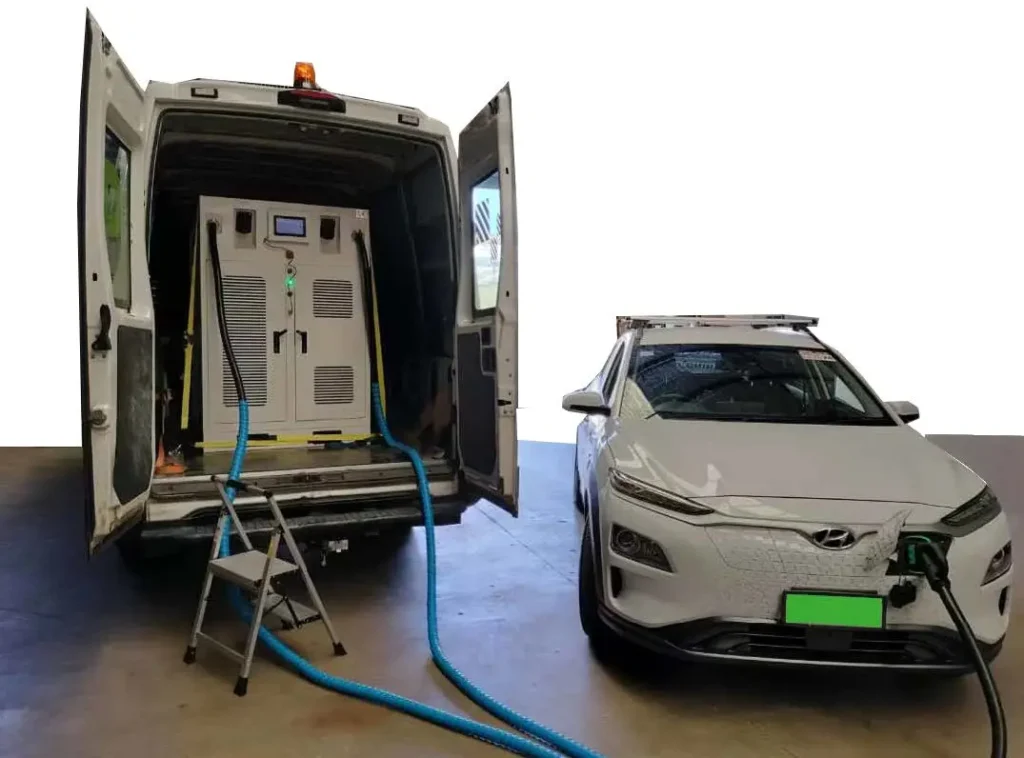Charging on the Go — Literally
What happens when you’re stuck in an EV dead zone — no charger in sight and 5% battery? That’s where mobile EV charging comes in. Whether you’re on a road trip, living off-grid, or need an emergency top-up, portable and on-demand charging services are changing the game in 2025.
In this guide, we’ll explore how mobile EV charging works, who offers it, and where it makes the most sense.

What Is Mobile EV Charging?
Mobile EV charging is the ability to charge an electric vehicle using a portable power source rather than a fixed station.
There are two main types:
- Portable EV Chargers:
- Handheld units that plug into standard outlets or generators
- Used for emergency charging or light use (e.g., 5–20 miles of range)
- Mobile Charging Vans or Trucks:
- Vehicles equipped with batteries, solar, or fuel-powered generators
- Deployed by services like SparkCharge, Blink Mobile, or EV Rescue
How It Works (Truck-Based Charging)
- You request a charge via app or hotline
- A charging van arrives at your location
- The van connects to your EV using CCS/NACS plugs
- Delivers a DC fast charge or Level 2 boost
- Pay by kWh or flat-rate emergency fee
Most vans can deliver 10–80 miles of range per session.

Best Use Cases for Mobile Charging
| Use Case | Why It Works |
|---|---|
| Emergency roadside charging | Like a gas can for your EV |
| Fleet support | Charge delivery vans or taxis on-the-fly |
| Event or festival sites | Temporary charging for attendees |
| Rural or underserved areas | No infrastructure? No problem |
| Vanlife/Overlanding | Great for remote explorers who don’t park near outlets |
Who Offers Mobile EV Charging in 2025?
- SparkCharge (U.S.) – On-demand fast charging via app
- Blink Mobile – Level 2 and DC vans at events and city centers
- EV Rescue Services – Partnered with AAA and other roadside providers
- Rental Companies – U-Haul and EVgo offer portable charging rentals
Costs & Limitations
- Expect to pay $15–$40 per session
- Often limited to 5–20 kWh per visit
- Coverage varies — most common in urban areas or highway corridors
FAQ
Q: Can I buy a mobile charging van?
Some companies sell kits, but they’re mostly commercial. DIY builds are possible with solar + battery storage.
Q: Is it bad for the battery to charge this way?
Not at all — it’s just another power source.
Q: Can I use it to fully charge an EV?
You can, but most services focus on partial, emergency, or quick boosts.

Final Thoughts
Mobile EV charging adds flexibility, security, and resilience to EV ownership. Whether you’re a commuter or a cross-country explorer, having charging come to you is a powerful backup plan.
Related reads:
- How to Set Up EV Charging in Off-Grid Areas
- EV Road Trip Planning: Tools, Tips & Chargers
- Top 5 Places to Charge Your EV for Free in 2025
Subscribe to VoltDriveHub for mobile charging trends, guides, and product reviews.






